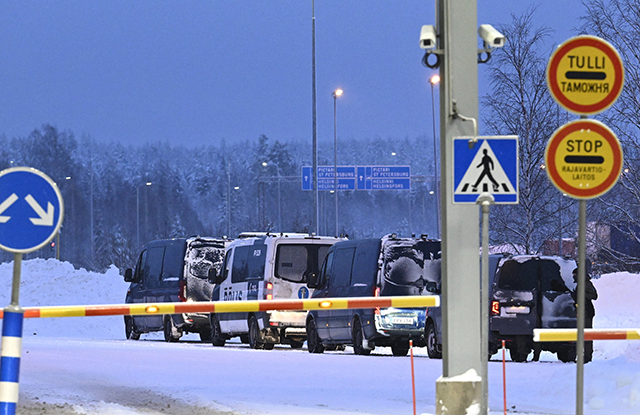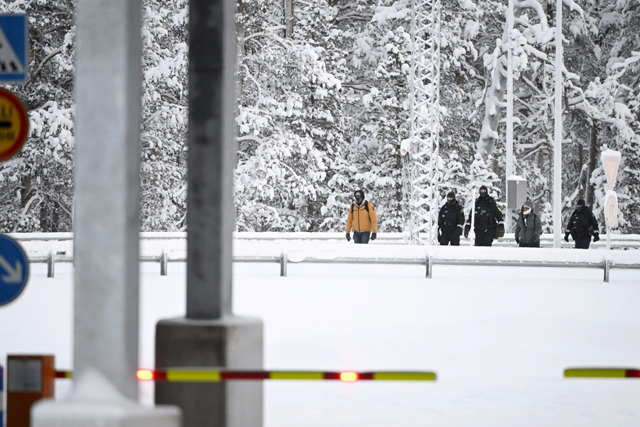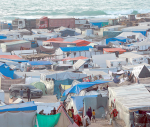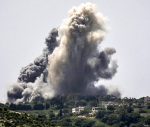You are here
NATO prepares for Russian threat in harsh Arctic
By AFP - Mar 12,2024 - Last updated at Mar 12,2024
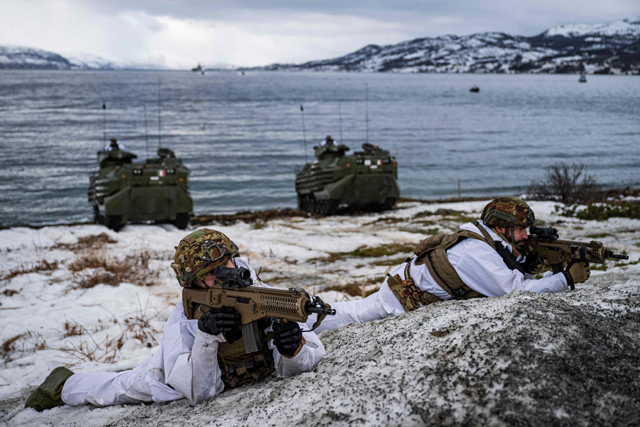
Italian Marines take position during an amphibious assault demonstration, part of the Nordic Response 24 military exercise on Sunday, at sea near Sorstraumen, above the Arctic Circle in Norway (AFP photo)
BADDEREN , Norway — Finnish conscript Atte Ohman readied himself aboard a US landing ship to storm a snow-swept Norwegian beach as part of a rapid response unit pushing out an invading enemy.
"There is a saying that 'if you want to keep the peace, you need to prepare for war'," the 19-year-old corporal told AFP, clutching his automatic rifle.
"That's what we're doing."
The simulated assault on NATO's frigid Arctic fringe was part of its sprawling, four-month Steadfast Defender exercise — the largest drills staged by the US-led military alliance since the Cold War.
Swedish gunboats sped to shore, Italian paratroopers abseiled from helicopters, and French marines emerged on skis.
The message was clear — NATO is prepared to protect itself in the face of an increasingly aggressive Russia two years into the Kremlin's war on Ukraine.
Last week the alliance got even larger as Sweden became its 32nd member almost a year after its Nordic neighbour Finland joined.
"We're signalling that we are ready to defend our territories and that's very important at the same time as strengthening our capabilities to operate together," Swedish Defence Minister Pal Jonson told AFP, after watching tanks from his country engage in a mock battle on the Norwegian-Finnish border.
"Right now the Russian ground forces are bogged down in Ukraine, but Russia has stated high ambitions to reconstitute itself and adapt its force posture."
As Russia has begun turning the tide on outgunned Ukrainian troops, there have been warnings that Moscow could one day turn its sights on a member of the alliance.
Kyiv's western allies meanwhile have struggled to ramp up production of crucial weaponry, and support for Ukraine is wavering.
Norway's defence chief Eirik Kristoffersen said the number of Russian forces stationed near his country is currently just one fifth of the number before Moscow's 2022 invasion of Ukraine.
“But on the maritime side, on the air side, and on the nuclear side, they’ve kept their forces intact in our region,” he told AFP.
“You have this uncertainty about for how long they will continue to lose so much versus Ukraine and then how long will it take for them to rebuild their military.”
Arctic focus
One increasingly crucial area of competition with Russia is the harsh Arctic region where the exercise was staged.
Under President Vladimir Putin, Russia has ramped up its capabilities in the region where melting ice due to global warming looks set to open up vital shipping routes and resources.
Now with the membership of Sweden and Finland, seven of the eight Arctic countries are in NATO and the allies say they’re increasingly pushing to compete with Moscow in this vital region.
The Arctic is becoming hugely strategic and “that’s why Russia is investing here a lot, and China is also watching this area,” said Finland’s defence minister Antti Hakkanen.
“The Artic is a new focus area. We must invest in the capabilities to act here in the normal military fields but also in the intelligence side and other fields,” he added.
Rear Admiral David Patchell, deputy commander of the US Second Fleet, said a conservative estimate was that climate would open up resources worth $1 trillion in the region. At the same time, melting ice would mean the Artic would link oceans around the globe for navigation.
“We have to know how to work in the Arctic,” he told AFP.
“We’re playing catch-up but I would say we’re cognisant of Russia’s priority, and they are placing a significant priority on the Arctic.”
Testing troops and hardware from across NATO in punishing Arctic conditions is a key focus of these exericises with the alliance’s Nordic members sharing their expertise.
“It’s a very big shock to come into working conditions like this. We rarely see snow like this on a daily basis,” said US Marine Corporal Joshua Maddox, who deployed from the temperate climes of North Carolina in the southern United States.
“The biggest challenge is just the mental aspect — just being very prepared.”
The Steadfast Defender drill — which involves warships sent from the US in a sign of Washington’s commitment — comes after Donald Trump rattled the foundations of the alliance.
The former president, the Republican challenger to Joe Biden in November elections, warned last month that he would encourage Russia to attack members not meeting financial commitments.
Related Articles
HELSINKI — Finnish President Sauli Niinisto spoke with his Russian counterpart Vladimir Putin on Saturday about the Nordic country's applica
HELSINKI — Finland will close its eastern border with Russia, its interior minister said on Thursday, hours after reopening it following a s
HELSINKI — Finland is ready to close its last border crossing with Russia if Moscow keeps pushing migrants across, Prime Minister Petteri Or


